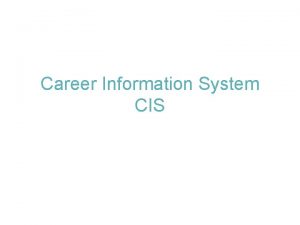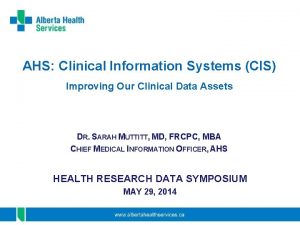CLINICAL INFORMATION SYSTEM A clinical Information System CIS




- Slides: 4

CLINICAL INFORMATION SYSTEM • A clinical Information System (CIS) is a computer based system that is designed for collecting, storing, manipulating and making available clinical information important to the healthcare delivery process. • Clinical Information Systems may be limited in extent to a single area (e. g. laboratory systems, ECG management systems) or they may be more widespread and include virtually all aspects of clinical information.

Some of the areas addressed by Clinical Information Systems are: • Clinical Decision Support: This provides users with the tools to acquire, manipulate, apply and display appropriate information to aid in the making of correct, timely and evidence-based clinical decisions. • Electronic Medical Records (EMRs): This contains information about the patient, from their personal details, such as their name, age, address and sex to details of every aspect of care given by the hospital. • Training and Research: Patient information can be made available to the physicians for the purpose of training and research.

Some of the benefits are: • Easy Access to Patient Data: Clinical Information Systems can provide convenient access to medical records at all points of care. • Structured Information: The clinical information captured in Clinical Information Systems is well organized. • Improved Drug Prescription and Patient Safety: Clinical Information Systems improve drug dosing and this leads to the reduction of adverse drug interactions.

Despite the benefits being offered by Clinical Information Systems, they are not without the barriers that prevent them from being rolled out in every hospital. These include some of the following: • Initial Cost of Acquisition: The high cost of basic infrastructure of clinical information technology can be a stumbling block to many healthcare organizations. • Privacy and Security: There are still huge concerns in the healthcare industry about the privacy of patient data on computer systems and how to keep such information secured. • Clinician Resistance: Clinicians usually have 10 -20 minutes to see their patients and if their interactions with a CIS during these sessions proves to be counterintuitive by taking up more than is necessary. • Integration of legacy Systems: This poses a stiff challenge to many organizations.







